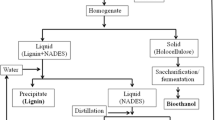Abstract
The main goal of this research is the enzyme-catalyzed conversion of fibre sludge into reducing sugars, which can further be transformed into higher alcohol biofuels by fermentation. Enzymatic hydrolysis of 1-allyl-3-methylimidazolium chloride ([AMIM]Cl) pretreated fibre sludge demonstrated that this cellulose-rich waste fraction can be successfully converted into reducing sugars. The organic material content of this fibre sludge was determined to be about 80 %. The relative yields of total reducing sugars (glucose) in this study were higher (maximum >95 %) compared with our earlier studies (34 %) of the same pretreatment procedure followed by acid hydrolysis and enzymatic hydrolysis. Due to the ionic liquid used in this study, we were able to recover 85 % (compared with 50 %) of the initial dry fibre sludge with [AMIM]Cl pretreatment.






Similar content being viewed by others
References
Ojanen P (2001) Sellu- ja paperitehtaiden lietteiden käsittely ja sen hyötykäyttö sekä niitä rajoittavat tekijät, Alueelliset ympäristöjulkaisut 223.
Holm J, Lassi U (2009) Cellulose fractionation from real sludge samples through ionic liquid [BMIM]Cl. Chem Eng Trans 17:1645–1650
Holm J, Lassi U, Romar H, Lahti R, Kärkkäinen J, Lajunen M (2012) Pretreatment of fibre sludge in ionic liquids followed by enzyme and acid catalysed hydrolysis. Cat Today 196(1):11–15
Swatlowski, R, Holbrey, J, Memon S, Caldwell G, Caldwell K, Rogers R (2004) Using Caenorhabditis elegans to probe toxicity of 1-alkyl-3-methylimidazolium chloride based ionic liquids, Chem. Commun., 668–669.
Wasserscheid P, Welton T (2008) Ionic liquids in synthesis. Wiley-VCH, Weinheim, p 75
Zhang H, Wu J, Zhang J, He J (2005) 1-Allyl-3-methylimidazolium chloride room temperature ionic liquid: a new and powerful nonderivatizing solvent for cellulose. Macromol 38:8272–8277
Srivastava N, Shukla M, Saha S (2010) An unusual effect of charcoal on the purification of alkylimidazolium iodide room temperature ionic liquids. Indian J Chem 49A:757–761
Ramesh S, Shanti R, Morris E (2012) Plasticizing effect of 1-allyl-3-methylimidazolium chloride in cellulose acetate based polymer electrolytes. Carbohyd Polym 87:2624–2629
Li B, Asikkala J, Filpponen I, Argyropoulos D (2010) Factors affecting wood dissolution and regeneration of ionic liquids. Ind Eng Chem Res 49:2477–2484
Lynd LR, Weimer PJ, van Zyl WH, Pretorius IS (2002) Microbial cellulose utilization: fundamentals and biotechnology. Microbiol Mol Biol Rev 66:506–577
Alvira P, Tomás-Pejó E, Ballesteros M, Negro MJ (2010) Pretreatment technologies for an efficient bioethanol production process based on enzymatic hydrolysis: a review. Bioresource Technol 101:4851–4861
Miller GL (1959) Anal Chem 31:426–428
Sigma–Aldrich, Glucose (GO) Assay Kit, Product Information (Product Code GAGO-20), Saint Louis, MO, USA
López-Pastor M, Ayora-Cañada M, Valcárcel M, Lendl B (2006) Association of methanol and water in ionic liquids elucidated by infrared spectroscopy using two-dimensional correlation and multivariate curve resolution. J Phys Chem B 110(22):10896–10902
Mahadeva S, Kim J (2012) Influence of residual ionic liquid on the thermal stability and electromechanical behavior of cellulose regenerated from 1-ethyl-3-methylimidazolium acetate. Fibers Polym 13(3):289–294
Canongia Lopes J, Costa Gomes M, Pádua A (2006) Nonpolar, polar, and associating solutes in ionic liquids. J Phys Chem B 110(34):16816–16818
Acknowledgments
This work has been carried out within the Forest Refine project (EU Interreg funding 00162639) and SusFuFlex project (Academy of Finland, project nr 124331) which are both gratefully acknowledged. The authors would also like to thank Ms. Anu-Sisko Perttunen for her efforts within this work.
Author information
Authors and Affiliations
Corresponding author
Rights and permissions
About this article
Cite this article
Holm, J., Zinchenko, G., Lassi, U. et al. Enzyme-catalyzed hydrolysis of fibre sludge into reducing sugars. Biomass Conv. Bioref. 3, 353–359 (2013). https://doi.org/10.1007/s13399-013-0082-6
Received:
Revised:
Accepted:
Published:
Issue Date:
DOI: https://doi.org/10.1007/s13399-013-0082-6




